Natural fixatives work like magical binding agents in your plant-based perfumes, attaching to scent molecules to dramatically extend their life on your skin. You'll notice deeper, more complex fragrances as these natural compounds from resins, woods, and herbs slow down the evaporation of volatile oils. When you use fixatives like frankincense, myrrh, or benzoin at the right concentrations, they'll transform your fleeting botanical blends into sophisticated scents that evolve throughout the day. Let's explore how these ancient ingredients can elevate your natural perfumery.
The Science Behind Natural Fixative Magic
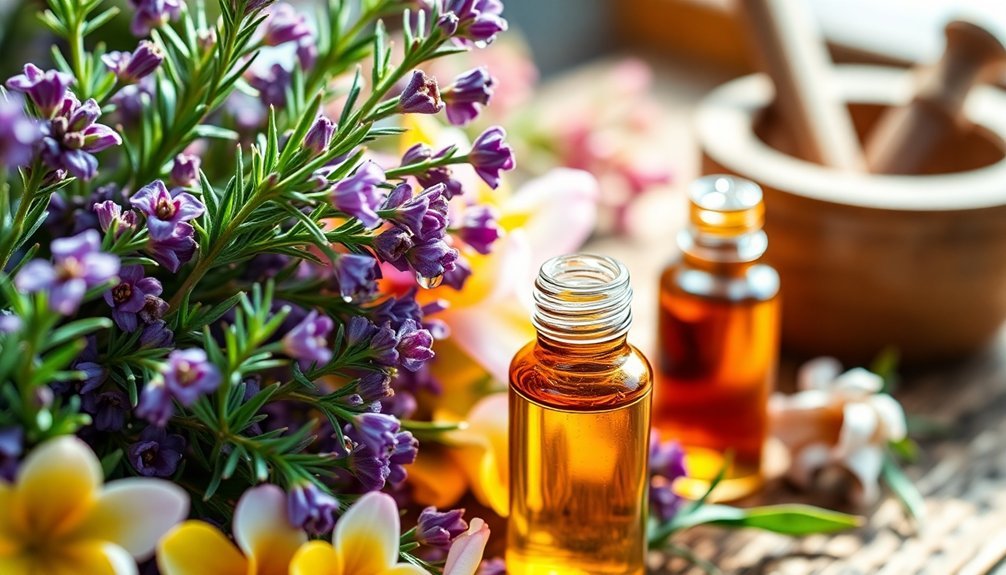
While many perfume enthusiasts focus on the aromatic ingredients, it's the natural fixatives that truly make plant-based fragrances come alive.
When you apply your favorite botanical perfume, these fixatives work silently but powerfully, binding with scent molecules to create a lasting impression on your skin.
You'll find these natural fixatives, derived from sources like labdanum and muskwood, acting as molecular anchors in your fragrance.
They raise the boiling point of volatile scent compounds, effectively slowing down their evaporation rate.
Without these natural stabilizers, your precious plant-based perfume would quickly disappear into thin air.
Instead, the fixatives guarantee you'll enjoy a consistent, well-balanced aroma throughout the day.
It's this clever chemical interaction that transforms a fleeting scent into a lasting signature fragrance.
The art of using fixatives reflects the delicate balance of extraction and transformation techniques perfected over centuries.
Ancient Wisdom of Plant-Based Fixatives
When you explore ancient perfumery, you'll find that sacred resins like frankincense and myrrh served as powerful natural fixatives in Egyptian, Greek, and Roman fragrances.
Plant-based formulas often combined these precious resins with olive oil as a carrier and aromatic ingredients like rose, iris, and cardamom. Today, these resinoids from plants remain essential components in natural perfumery, offering both fixative properties and rich aromatic profiles.
You can trace these time-tested techniques through archaeological evidence, including the discovery of perfume workshops dating back to 1850 B.C., and detailed documentation in classical texts like Theophrastus' "On Odors."
Traditional Sacred Resins
Throughout history, sacred resins like frankincense and myrrh have played an essential role in perfumery, medicine, and spiritual practices across diverse cultures. You'll find these precious substances still being sustainably harvested from Boswellia and Commiphora trees, often collected from natural injuries to protect the species. These resins are typically used at 3-5% concentration in perfume formulations.
| Resin Type | Key Benefits | Traditional Uses |
|---|---|---|
| Frankincense | Natural fixative | Religious ceremonies |
| Myrrh | Therapeutic compounds | Medicine and salves |
| Combined resins | Enhanced longevity | Perfume blending |
When you're creating plant-based perfumes, these resins serve as excellent natural fixatives, helping to slow down the evaporation of volatile compounds while adding depth to your blends. Their therapeutic properties, combined with their ability to stabilize fragrances, make them invaluable ingredients in modern natural perfumery.
Historical Herbal Formulas
Since ancient times, herbal formulas have formed the backbone of traditional perfumery, with civilizations from Sumer to Rome developing sophisticated methods for creating long-lasting fragrances.
You'll find that these ancient formulas relied on complex combinations of essential oils containing compounds like linalool, eugenol, and terpinen-4-ol, which naturally extended a perfume's longevity.
When you explore traditional herbal fixatives, you'll discover that plants like rosemary, myrtle, and bay leaves weren't chosen randomly.
Their specific chemical compositions made them effective natural preservatives and fragrance enhancers.
These time-tested ingredients continue to influence modern plant-based perfumery, and you can still benefit from their fixative properties today.
Many of these herbs serve dual purposes, offering both aromatic appeal and the ability to stabilize more volatile scent components.
Top Natural Resins for Lasting Scents
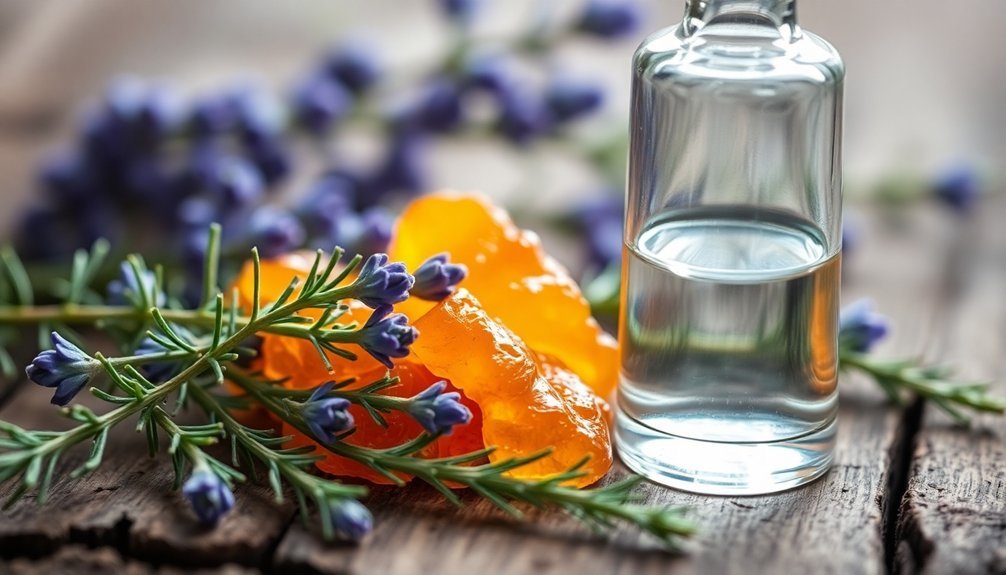
You'll find that natural resins offer remarkable staying power in plant-based perfumes, with benzoin's sweet, warm aroma acting as an exceptional leather-note fixative.
Frankincense's molecular structure works its ancient magic by naturally extending your fragrance's life while adding piney, spicy dimensions.
Myrrh rounds out the top resin trio with its deep, woody warmth that anchors your perfume's base notes for lasting wear.
Benzoin's Sweet Holding Power
A sweet symphony of vanilla-like notes and balsamic warmth emanates from benzoin, one of nature's most cherished fixatives derived from the Styrax benzoin tree.
You'll find this precious resin carefully harvested from trees in southeastern Asia, where farmers scale heights of up to 30 feet to collect its aromatic tears.
When you're crafting natural perfumes, benzoin's magic lies in its ability to slow down the evaporation of volatile compounds while adding depth to your blend.
At a 3-5% concentration, it'll anchor your lighter notes and extend your fragrance's longevity.
You can pair it seamlessly with other fixatives like labdanum and myrrh, creating complex base notes that enhance your perfume's staying power.
For best results, apply your benzoin-infused creation to pulse points, where it'll interact with your skin chemistry.
Ancient Frankincense Magic Revealed
While ancient civilizations treasured frankincense for its spiritual significance, modern perfumers prize this aromatic resin for its exceptional fixative properties.
You'll find this natural wonder, derived from the Boswellia tree, extends the life of your DIY perfumes by slowing down the evaporation of fragrance molecules.
To harness frankincense's magic in your blends, aim for a 3-5% concentration, using about one-third the amount of your total fragrance oil.
It works beautifully with other base notes like patchouli and vetiver, creating rich, lasting scents.
Let your blend mature for 24 hours to achieve ideal results.
You'll appreciate not only its fixative power but also its cost-effectiveness and versatility in various applications, from solid perfumes to aromatic candles.
Myrrh's Deep Anchoring Effects
Much like frankincense's ancient legacy, myrrh stands as another prized resin in the natural perfumer's toolkit. You'll find this remarkable fixative working at 3-5% concentration to anchor your volatile fragrance components, ensuring they stay put on your skin.
| Property | Benefit |
|---|---|
| Fixative Power | Slows evaporation of lighter notes |
| Aroma Profile | Warm, rich, resinous with earthy spice |
| Blending Affinity | Pairs with florals, woods, spices |
| Skin Benefits | Moisturizing, antimicrobial, soothing |
When you're crafting plant-based perfumes, you'll appreciate how myrrh's extracted resins harmonize with frankincense, amber, vanilla, and rose. The extraction process, beginning with tree sap collection and ending with either steam distillation or solvent extraction, yields an oil that's perfect for your natural fragrance creations.
Creating Depth With Botanical Fixatives
Creating depth in natural perfumes relies heavily on botanical fixatives, which serve as the foundation for lasting fragrances.
You'll find that plant resins like benzoin and tolu balsam add natural sweetness while providing essential warmth to your perfume's base notes.
When you're formulating your fragrance, aim to use these fixatives at 3-5% concentration in the base.
They'll work by slowing down the evaporation of your more volatile compounds and equalizing vapor pressures.
You'll notice how patchouli and vetiver effectively anchor lighter notes, while frankincense and sandalwood create rich, woody undertones.
To maximize longevity, apply your perfume to pulse points where body heat will activate the fixatives.
Remember that environmental factors and your skin's natural pH will influence how these botanical elements interact with your fragrance.
Essential Herbs That Lock in Fragrance
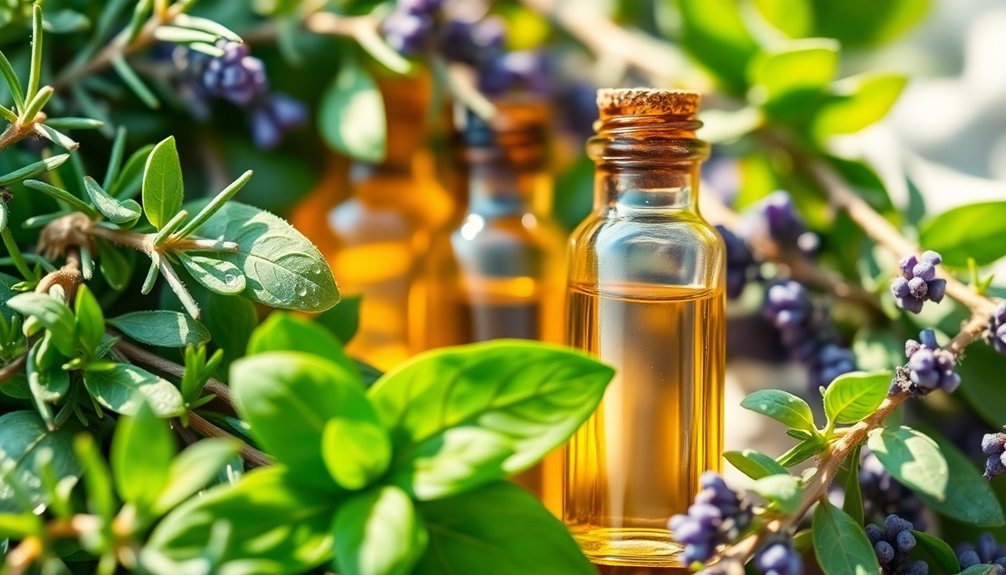
You'll find remarkable plant-based staying power in clary sage, which serves as a natural replacement for expensive traditional fixatives while adding complex herbal depth to your perfume blends.
Whether you're working with lavender's enduring properties or sacred basil's ability to anchor volatile compounds, these essential herbs provide reliable scent stabilization for natural fragrances.
Clary Sage's Aromatic Power
The remarkable fixative properties of clary sage make it a powerhouse in natural perfumery. When you're crafting plant-based fragrances, you'll find this herb excels at slowing down the evaporation of volatile compounds while anchoring lighter notes.
Its musky undertones add depth and complexity to your blends without overwhelming the intended scent profile.
What makes clary sage particularly valuable is its rich chemical composition. The presence of linalyl acetate and linalool doesn't just extend your perfume's longevity – it also brings therapeutic benefits.
You'll appreciate how it complements other natural fixatives like patchouli and vetiver, creating well-balanced, long-lasting fragrances.
Whether you're working with dry or oily bases, clary sage's versatility makes it an essential addition to your natural perfumery toolkit.
Lavender's Long-Lasting Effects
While many natural perfumers appreciate lavender for its delicate floral notes, its true potential emerges when paired with the right fixatives. You'll find that natural fixatives like vanilla Madagascar, benzoin, and vetiver can transform your lavender perfume from a fleeting scent to a lasting impression.
They work by slowing down the evaporation of fragrance compounds, helping your signature scent stay with you throughout the day.
To maximize your lavender perfume's longevity, consider these essential tips:
- Apply to pulse points where natural skin oils and body heat enhance fragrance retention
- Choose perfumes with a 20% concentration of essential oils for best staying power
- Layer complementary fixatives like sandalwood or frankincense to create depth and stability
The secret lies in understanding how these fixatives interact with both the lavender notes and your skin chemistry.
Sacred Basil Scent Stabilization
Building upon lavender's fixative partnerships, sacred basil brings its own unique stabilizing properties to natural perfumery.
You'll find its herbal, spicy profile with distinctive clove notes can enhance your fragrance compositions when properly stabilized. Due to its high methyl eugenol content, you'll need to limit sacred basil to trace amounts (less than 0.01%) in fine fragrances.
To maximize sacred basil's potential, you'll want to pair it with natural fixatives at 3-5% concentration. Consider combining it with patchouli or vetiver to anchor its volatile compounds and extend their release.
For best results, store your sacred basil blends in cool, dry conditions away from sunlight. You can create more depth in your green, chypre, or spicy formulations while ensuring the scent remains stable throughout its intended lifecycle.
Sustainable Sources of Natural Fixatives
Natural perfumery's shift toward sustainable fixatives represents an essential evolution in fragrance production.
When you choose plant-based perfumes with sustainable fixatives, you're supporting responsible harvesting practices that protect rare species while benefiting local communities through fair trade initiatives.
You'll find that sustainable natural fixatives offer remarkable environmental advantages by reducing the industry's reliance on petrochemicals and lowering its carbon footprint.
These eco-friendly alternatives also promote animal welfare by eliminating the need for animal-derived ingredients and cruel testing methods.
- Small-scale farmers gain alternative income sources through sustainable fixative cultivation
- Native plant species thrive as sustainable practices reduce wild harvesting pressure
- Local economies benefit from fair trade partnerships while preserving biodiversity
These sustainable choices guarantee your fragrance not only smells divine but also supports planetary health and ethical practices.
Blending Techniques for Maximum Longevity
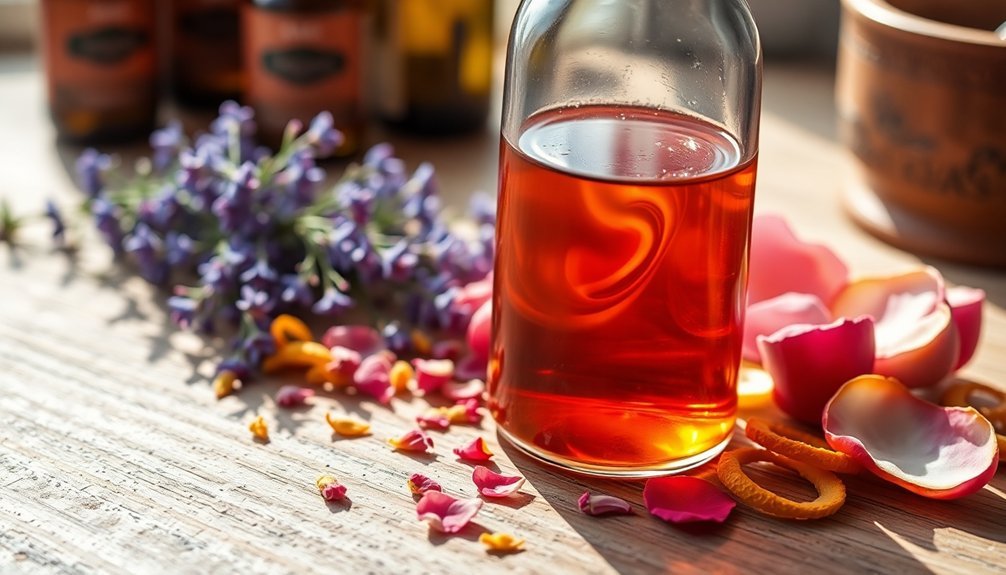
To achieve lasting plant-based fragrances, proper blending techniques with natural fixatives prove essential for extending wear time and maintaining scent integrity.
You'll want to start by incorporating plant resins like benzoin or myrrh at 3-5% concentration in your base notes, as they effectively slow down the evaporation of volatile compounds.
Layer your fragrance strategically by starting with fixative-rich base notes of patchouli or vetiver, which anchor the lighter notes above them.
These earthy oils work synergistically with resins to trap and slowly release middle and top notes throughout the day.
For oriental or woody blends, consider adding frankincense or sandalwood to further stabilize the vapor pressures.
From Garden to Bottle: Growing Your Fixatives
While mastering blending techniques enhances your perfume's longevity, growing your own fixative plants offers a deeper connection to natural fragrance creation.
You'll need to understand specific growing conditions and timing to cultivate plants like clary sage and iris successfully. Focus on rich, well-drained soil and establish proper watering routines to maximize your plants' aromatic properties.
Harvest your fixative plants during prime times – typically early morning when essential oil content peaks.
Remember that each plant species requires unique care and precise conditions to develop its full fragrance potential.
- Choose organic cultivation methods to guarantee pure, chemical-free fixatives for your perfumes
- Create microclimate zones in your garden to support different fixative species' needs
- Practice manual harvesting and immediate processing to preserve aromatic compounds
The Art of Extracting Natural Fixatives

Mastering the extraction of natural fixatives requires understanding both traditional and modern techniques. While conventional methods like Soxhlet extraction and maceration have served perfumers for generations, they're time-consuming and resource-intensive, often yielding less-than-optimal results.
You'll find more efficiency in non-conventional methods like ultrasound-assisted extraction (UAE) and supercritical fluid extraction (SFE). These techniques preserve bioactive compounds while using less energy and fewer solvents.
For extracting aromatic compounds, you can rely on distillation processes – both steam and hydro variants effectively separate volatile components from plant materials.
When working with resinous plants like frankincense or myrrh, you'll need to choose your extraction method carefully. These materials, along with herbs and roots like orrisroot and vetiver, require specific techniques to preserve their unique fixative properties.
Combining Fixatives for Signature Scents
With your extraction techniques perfected, creating signature scents becomes an exciting venture into artful combinations.
You'll want to start with a 3-5% concentration of fixatives in your base notes, carefully balancing natural options like benzoin, myrrh, and vanilla Madagascar.
When blending, follow the 2:1:1 ratio for base, heart, and head notes while adjusting the fixative to about one-third of your total fragrance oil.
- Combine different fixatives like patchouli and vetiver to create unique foundational aromas that complement your chosen scent profile
- Test your blends on multiple mediums and let them mature for 30 days to achieve proper binding
- Mix natural fixatives with similar natural fragrances for seamless integration, adjusting concentrations to balance longevity with projection
Natural Fixative Storage and Shelf Life
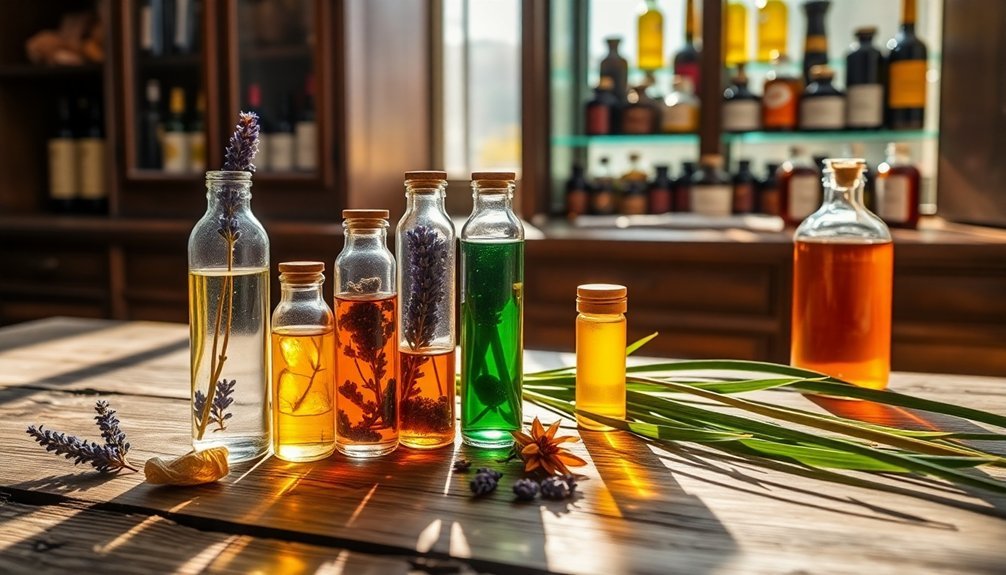
Proper storage of natural fixatives plays an essential role in preserving your perfume's longevity and scent profile.
You'll need to store your fragrances in a cool, dark place using dark-colored glass bottles to prevent photodegradation and maintain temperature stability. Keep them away from windows and heat sources to protect the fixatives' performance.
Monitor your perfumes every few months by checking their scent profiles and watching for signs of degradation.
While natural fixatives don't guarantee a specific shelf life, they'll extend your perfume's longevity considerably when stored correctly. You can ascertain several years of enjoyment by maintaining consistent storage conditions and low humidity levels.
Regular inspections help you identify potential issues early, allowing you to adjust storage practices before they impact your perfume's quality and integrity.
Measuring and Balancing Fixative Ratios
Accurate measurement of fixative ratios forms the foundation of successful plant-based perfumery. You'll want to start with a 3-5% concentration of natural fixatives in your base notes to anchor lighter scents effectively.
When blending, aim for a 20-30% fragrance oil concentration, with fixatives making up about one-third of that amount.
For the best results with your plant-based perfumes:
- Follow a 2:1:1 ratio for base, heart, and top notes as your starting point
- Choose complementary fixatives like benzoin for warmth or patchouli for anchoring lighter notes
- Allow your blend to rest for 24 hours before making final adjustments
Remember that different scent families require different ratios – oriental fragrances work well with civet, while woody scents pair beautifully with sandalwood.
Frequently Asked Questions
Can Pregnant Women Safely Use Perfumes Containing Natural Fixatives?
You'll be safer using perfumes with natural fixatives while pregnant, but you should still consult your doctor first. Even natural ingredients can affect pregnancy, so it's best to limit fragrance use overall.
Do Natural Fixatives Lose Effectiveness When Exposed to Direct Sunlight?
Yes, your natural fixatives will lose effectiveness when exposed to direct sunlight. UV rays break down their molecular structure, increase evaporation rates, and reduce their ability to stabilize fragrances. Always store them properly.
How Do Temperature Fluctuations Affect Natural Fixative Performance?
Temperature changes can dramatically impact your natural fixatives' performance. You'll notice they're less effective in high heat, as warmth accelerates evaporation and alters molecular behavior, reducing their ability to stabilize fragrances.
Can Natural Fixatives Cause Staining on Light-Colored Clothing?
Yes, natural fixatives can stain your light-colored clothes due to their oily, pigmented nature. You'll need to be careful when applying perfumes containing ingredients like benzoin, myrrh, or tolu balsam to prevent permanent marks.
Which Skin Types Respond Best to Natural Fixative-Based Perfumes?
You'll find natural fixative-based perfumes work best with normal skin types, but they're effective for all skin types. On oily skin, they balance intensity, while on dry skin, they help fragrances last longer.
In Summary
You'll find that mastering natural fixatives revolutionizes your plant-based perfume making. Now that you've explored their science, history, and practical applications, you're ready to create longer-lasting, more complex fragrances. Remember to experiment with different combinations, store your fixatives properly, and trust your nose. Let these ancient plant allies transform your botanical blends into sophisticated, enduring scents that tell your unique aromatic story.

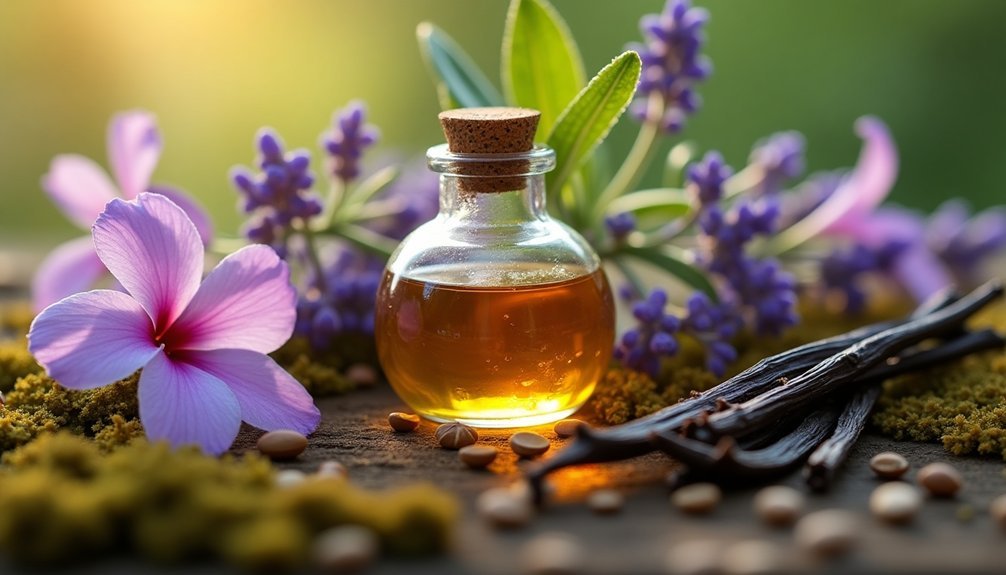
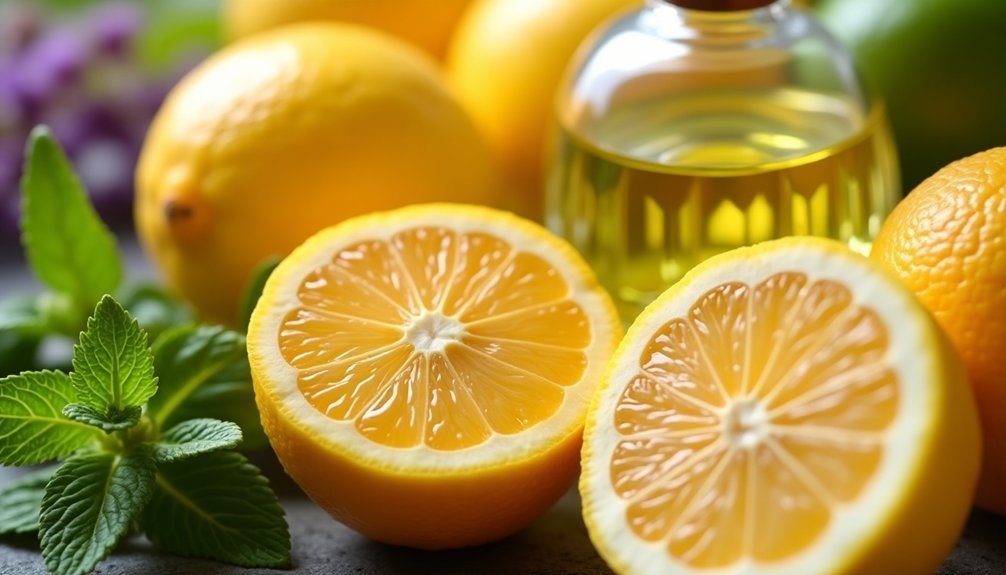
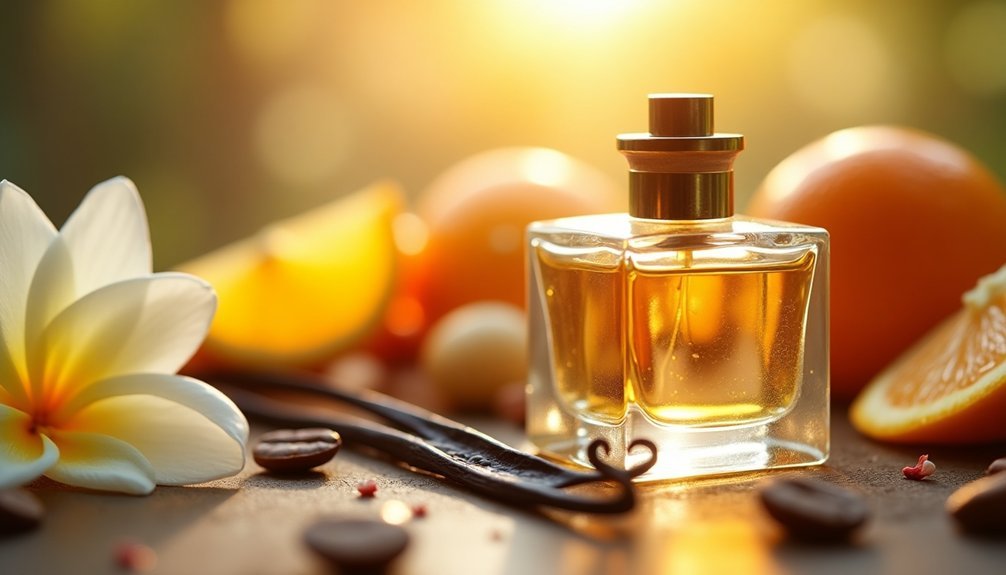

Leave a Reply